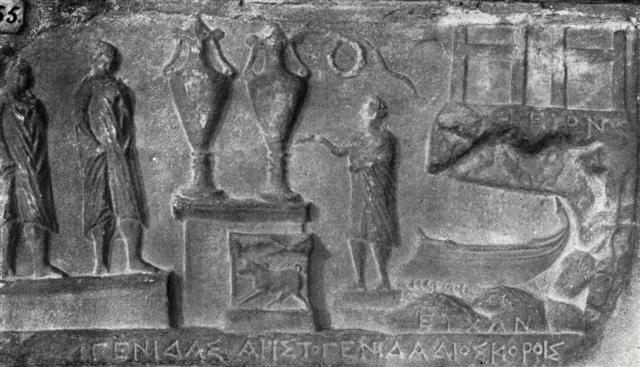|
5. To continue with the description of Allen: "Another symbol was a Pile of Bricks, referring to the building of the first city and the fraticidal brothers - the Romulus and Remus of Roman legend; although this with a very different character from that generally assigned to our Heavenly Twins. Similarly Sayce says that the Sumerian name for the month May-June, when the sun was in Gemini, signified 'Bricks' (?). In classical days the constellation was often symbolized by two stars over a ship; and having been appointed by Jove as guardians of Rome, they naturally appeared on all early silver coinage of the republic from about 269 B.C., generally figured as two young men on horseback, with oval caps, surmounted by stars, showing the halves of the egg-shell from which they issued at birth." The lower halves of the egg-shell were possibly transformed into urns (amforas), because eggs are inherently unstable constructions and tend to roll over:  The ship of Argenidas is perhaps protected by the pair of 'dokana' above. The 'pile of bricks', the heap of building material, is probably, I guess, related to the Chinese name for χ Gemini: ... χ, a 4th magnitude, with α Cancri, was the Chinese Tseih Tsing, Piled-up Fuel ... A heap of building material can consist of suitable wooden beams. More from Allen: "The sign's symbol, `, has generally been considered the Etrusco-Roman numeral, but Seyffert thinks it a copy of the Spartans' emblem of their Twin Gods carried with them in battle. Brown derives it from the cuneiform
the ideograph of the Akkad month Kas, the Twins, the Assyrian Simānu, corresponding to parts of our May and June when the sun passed through it. The constellation was certainly prominent on the Euphrates, for five of its stars marked as many of the ecliptic divisions of that astronomy." I think the original idea was 'raising the roof of the sky' and the Egyptian quartet of 'sky pillars' was designed very much like the cuneiform Kas, cfr at Heka:  Raising the sky to let in the Sun light should once have been connected with spring equinox rather than midsummer, but precession has moved the roof. Also on Easter Island the new construction work was in high summer (in the month Ko Ruti), cfr at Ure Honu: ... In The Eighth Land Barthel has coordinated the months with activities:
An amusing little story from Makemson is suitable for concluding this chapter: "It must be admitted, however, that the task of raising the sky was not always a long and arduous one. In the New Hebrides of Melanesia the sky was formerly so low overhead that a woman who was pounding roots in a mortar happened to strike the sky with her pestle. Greatly annoyed at the interruption she looked up and cried angrily, 'Go on up higher!' Whereat the sky meekly obeyed her. What actually happened probably was that the woman struck the low house roof with her pestle and cried angrily to her husband, 'If you don't raise that roof higher, I won't cook you another meal!' thus giving a strong impuls to the development of the science of architecture." |
